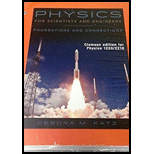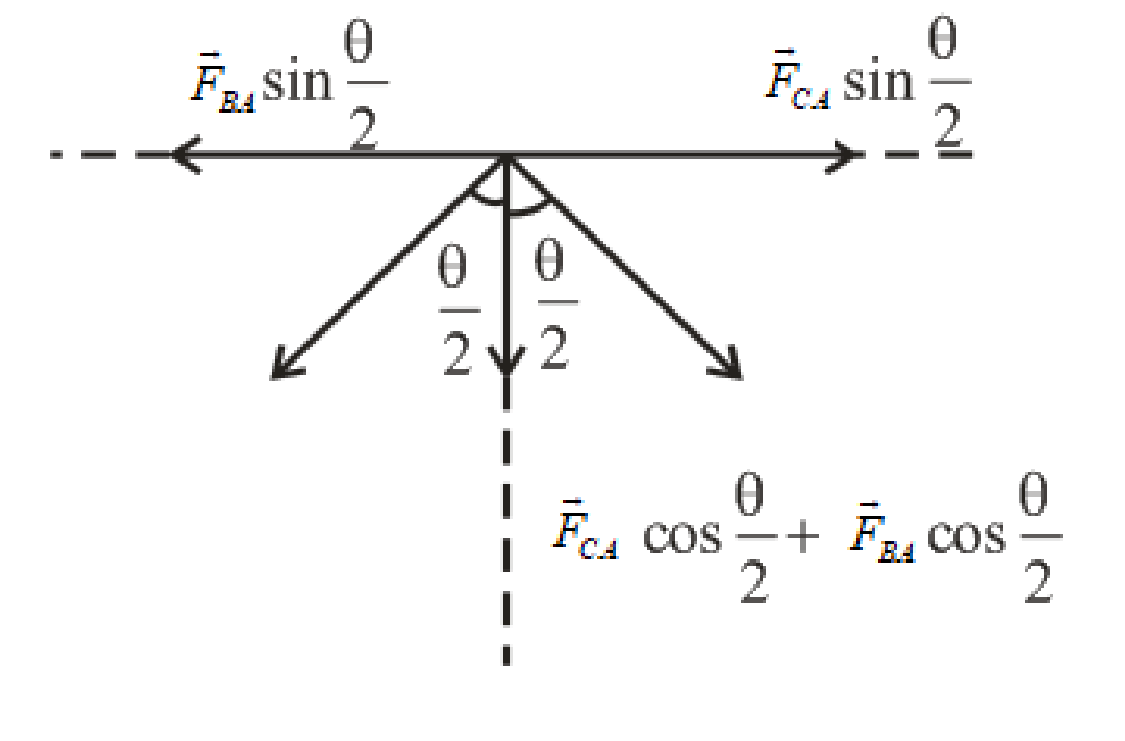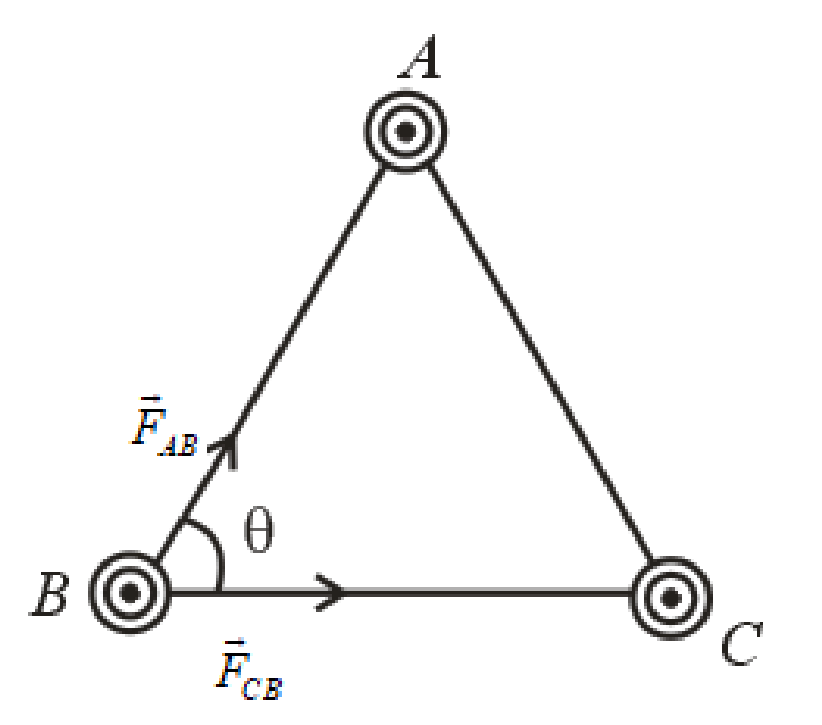
Concept explainers
(a)
Find the force per unit length exerted on wire A.
(a)
Answer to Problem 65PQ
The force per unit length exerted on wire A is
Explanation of Solution
The curent flowing in all the wires is in the same direction. Therefore, the wires will be attracted towards each other.
The forces acting on the wire A due to the current in the wire B and wire C are as shown below.

Write the expression for force exerted on wire A due to current in wire C as.
Here,
Write the expression for force exerted on wire A due to current in wire B as.
Here,
The components of the forces

Write the expression for component of the forces along the X-axis as.
Here,
Write the expression for component of the forces along the Y-axis as.
Here,
Write the expression for the net force on the wire A as.
Here,
The distance between all the three wires is same. Therefore the wires form an equilateral triangle. So, the angle between the two forces is
Conclusion:
Substitute
Substitute
Substitute
Substitute
Substitute
Thus, the force per unit length exerted on wire A is
(b)
Find the force per unit length exerted on wire B.
(b)
Answer to Problem 65PQ
The force per unit length exerted on wire B is
Explanation of Solution
The forces acting on the wire A due to the current in the wire B and wire C are as shown below.

Write the expression for force exerted on wire B due to current in wire A as.
Here,
Write the expression for force exerted on wire B due to current in wire Cas.
Here,
The components of the forces

Write the expression for component of the forces along the X-axis as.
Here,
Write the expression for component of the forces along the Y-axis as.
Here,
Write the expression for the net force on the wire B as.
Here,
The wires form an equilateral triangle. So, the angle between the two forces is
Conclusion:
Substitute
Substitute
Substitute
Substitute
Substitute
Thus, the force per unit length exerted on wire B is
Want to see more full solutions like this?
Chapter 30 Solutions
Physics for Scientists and Engineers: Foundations and Connections
- Two parallel wires are separated by 6.00 cm, each carrying 3.00 A of current in the same direction. (a) What is the magnitude of the force per unit length between the wires? (b) Is the force attractive or repulsive?arrow_forwardThree long, straight wires are seen end-on in the figure below. The distance between the wires is r = 0.250 m. Wires A and B carry current IA = IB = 1.60 A, and wire C carries current IC = 3.06 A. Assume (for example) the only forces exerted on wire A are due to wires B and C. Find the force per unit length exerted on the following. (Express your answers in vector form.)arrow_forwardA particle of charge -6.25 nC experiences a force of 1.25 N when it is moving at 3.75 x 10^4 m/s. Its motion is perpendicular to the magnetic field produced by a current-carrying wire, which is 3.0 cm from it. (a) What is the magnitude of the magnetic field? (b) How much current flows through the wire?arrow_forward
- The force per meter between the two wires of a jumper cable being used to start a stalled car is 0.225 N/m. (a) What is the current in the wires, given they are separated by 2.00 cm? (b) Is the force attractive or repulsive?arrow_forwardwo parallel wires are separated by 5.70 cm, each carrying 2.90 A of current in the same direction.(a) What is the magnitude of the force per unit length between the wires? N/m(b) Is the force attractive or repulsive?arrow_forwardAn infinitely long, solid, cylindrical conductor of radius R carries a current I. Which graph correctly shows the magnetic field strength inside and outside the conductor?arrow_forward
- Select the correct expression for the magnitude of electromotive force (e.m.f) of a straight conductor of length l moving with the velocity v perpendicular to a magnetic field B.arrow_forwardA particle of charge -6.25 nC experiences a force of 1.25 N when it is moving at 3.75 x 104 m/s. Its motion is perpendicular to the magnetic field produced by a current-carrying wire, which is 3.0 cm from it. (a) What is the magnitude of the magnetic field? (b) How much current flows through the wire? (If possible, can I get the answer in not more than 45 mins please? Thank you)arrow_forwardAn alpha particle (consisting of two protons and two neutrons), traveling at a speed of v = 1.4 x 105 m/s, enters a region of constant magnetic fi eld of strength B = 1.8 T as shown in the fi gure. The direction of B is out of the image. The alpha follows a path that is a circular arc of radius r. Part (b) In units of elementary charge e, what is the electric charge q of an alpha particle? Part (c) In meters, what is the radius of curvature r of the path taken by the alpha particle?arrow_forward
- An alpha particle (consisting of two protons and two neutrons), traveling at a speed of v = 1.7 x 105 m/s, enters a region of constant magnetic fi eld of strength B = 1.4 T as shown in the fi gure. The direction of B is out of the image. The alpha follows a path that is a circular arc of radius r. Part (a) In atomic mass units, what is the mass m of an alpha particle? Part (b) In units of elementary charge e, what is the electric charge q of an alpha particle? Part (c) In meters, what is the radius of curvature r of the path taken by the alpha particle?arrow_forwardConsider a wire carrying a current due east in a location where the Earth’s field is due north. A) What is the direction of the force on the wire if both are parallel to the ground? B) Calculate the force per unit length on the wire, in newtons per meter, if the wire carries 19.5 A and the field strength is 2.85 × 10-5 T. C) What would the diameter be, in meters, of copper wire (with density ρ = 8.80 × 103 kg/m3) that would have its weight supported by this force in meters? D) Calculate the resistance per unit length, in ohms per meter, that this copper wire will have. Copper has a resistivity of ρR = 1.72 × 10-8 Ω⋅m. E) Calculate the potential difference per unit length, in volts per meter, of this wire.arrow_forwardThree long, straight wires are seen end-on in the figure below. The distance between the wires is r = 0.258 m. Wires A and B carry current IA = IB = 1.54 A, and wire C carries current IC = 3.42 A. Assume (for example) the only forces exerted on wire A are due to wires B and C. Find the force per unit length exerted on the following. (Express your answers in vector form.) (a) wire A fA = N/m (b) wire B fB = N/marrow_forward
 College PhysicsPhysicsISBN:9781305952300Author:Raymond A. Serway, Chris VuillePublisher:Cengage Learning
College PhysicsPhysicsISBN:9781305952300Author:Raymond A. Serway, Chris VuillePublisher:Cengage Learning University Physics (14th Edition)PhysicsISBN:9780133969290Author:Hugh D. Young, Roger A. FreedmanPublisher:PEARSON
University Physics (14th Edition)PhysicsISBN:9780133969290Author:Hugh D. Young, Roger A. FreedmanPublisher:PEARSON Introduction To Quantum MechanicsPhysicsISBN:9781107189638Author:Griffiths, David J., Schroeter, Darrell F.Publisher:Cambridge University Press
Introduction To Quantum MechanicsPhysicsISBN:9781107189638Author:Griffiths, David J., Schroeter, Darrell F.Publisher:Cambridge University Press Physics for Scientists and EngineersPhysicsISBN:9781337553278Author:Raymond A. Serway, John W. JewettPublisher:Cengage Learning
Physics for Scientists and EngineersPhysicsISBN:9781337553278Author:Raymond A. Serway, John W. JewettPublisher:Cengage Learning Lecture- Tutorials for Introductory AstronomyPhysicsISBN:9780321820464Author:Edward E. Prather, Tim P. Slater, Jeff P. Adams, Gina BrissendenPublisher:Addison-Wesley
Lecture- Tutorials for Introductory AstronomyPhysicsISBN:9780321820464Author:Edward E. Prather, Tim P. Slater, Jeff P. Adams, Gina BrissendenPublisher:Addison-Wesley College Physics: A Strategic Approach (4th Editio...PhysicsISBN:9780134609034Author:Randall D. Knight (Professor Emeritus), Brian Jones, Stuart FieldPublisher:PEARSON
College Physics: A Strategic Approach (4th Editio...PhysicsISBN:9780134609034Author:Randall D. Knight (Professor Emeritus), Brian Jones, Stuart FieldPublisher:PEARSON





